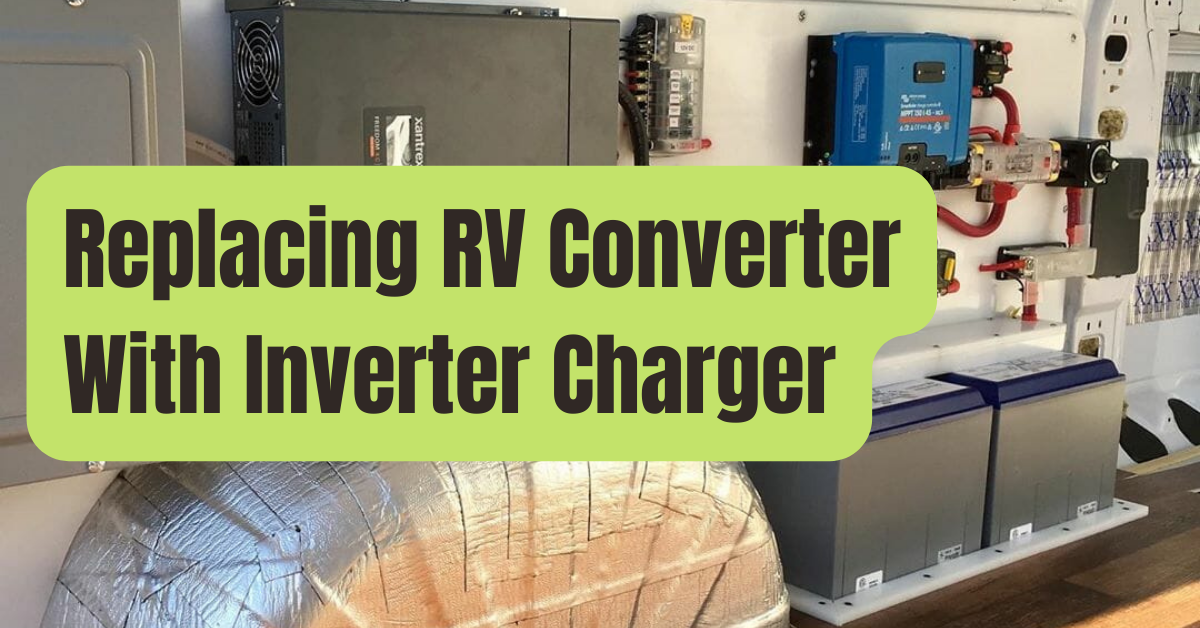If you spend a lot of time boondocking, inverter chargers are an essential RV item.
It can charge your battery bank in addition to converting DC power to AC power.
Many RV owners change the present converter with this popular modification.
When choosing an inverter/charger, size and type are the two primary factors to consider.
This post will go over the characteristics of inverter/chargers and how to choose the best one for your recreational vehicle.
#1. AIMS Power

- 2000W continuous, 6000W surge (20 seconds)
- 16A, 120V pure sine wave
- 70A smart battery charger
#2. Go Power

- 3000W pure sine wave inverter; 4800W surge (5 seconds), 6000W surge (1 second)
- 120V pure sine wave
- 125A battery charger
#3. Xantrex

- 3000W continuous, 6000W surge output
- 120V pure sine wave
- 150A battery charger
#4. Victron Energy

- 3000W continuous, 6000W sur
- ge output
- 25A, 120V pure sine wave
- 120A battery charger
What Is A Charger/Inverter?
Inverter chargers are made of of inverters and smart converters.
They can provide electricity to operate domestic gadgets from your RV battery bank as well as charge your battery bank with city power.
If you often go boondocking or off-grid camping, inverter chargers may be quite helpful.
You cannot power 120V gadgets like coffee makers, computers, hair dryers, or microwaves without an inverter/charger.
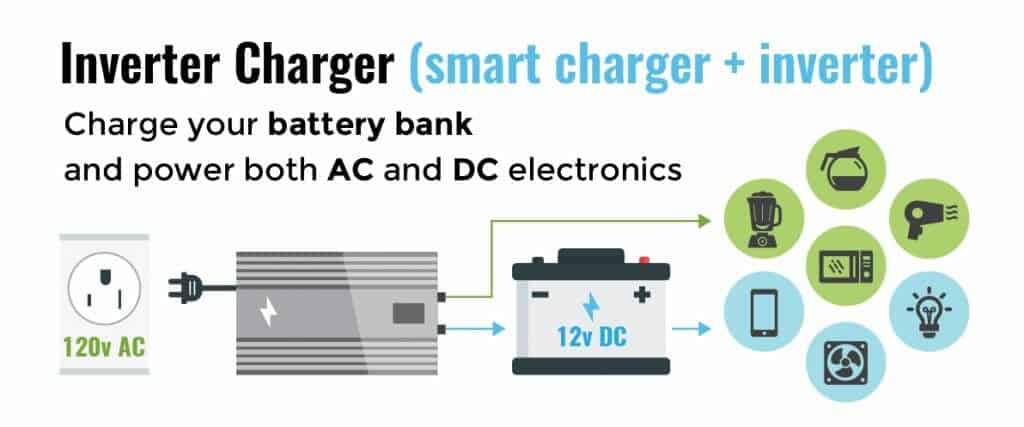
How Can an Inverter/Charger Be Used?
- DC to AC power conversion
- Fill up your battery pack.
- 12 volt DC electronics power
- Home electronics using AC power
Improve Your Converter
A converter is often pre-installed in RV motorhomes.
They typically reside underneath the AC breaker panel.
Converters are straightforward, single-stage devices that transform 120v AC power into 12v DC power, steadily charge your battery bank, and power your RV all at once.
This works fine while you are connected to city electricity, but it is not very useful when you are off-grid camping.
Fortunately, updating your converter is an easy operation with plenty of advantages.
You may wish to upgrade to an inverter/charger for the following reasons.
- Your battery bank may be charged by them.
- They provide every advantage of a smart converter.
- All of your gadgets may be used off the grid.
- Two devices may be replaced by one one.
- The majority have an automated transfer switch built in, so unlike a typical inverter, you don’t have to manually turn them on and off.
- An automated generator start function is a common component of inverter chargers. The inverter will send a command to the generator to start and operate until the batteries are fully charged if they get too low. By doing this, the battery bank will remain full and the energy will continue to flow.
- They work with all kind of batteries.
What Sort Of Inverter To Purchase
Waves of good and negative energy are transmitted through households.
In contrast to how 12 volt DC electricity flows via circuits, this.
There are two techniques to invert electricity from DC to AC: using a modified sine wave (MSW) or a pure sine wave (PSW).
Another form of power inverter is the square wave, although as they are an older design, MSW and PSW inverters have mostly taken their place.
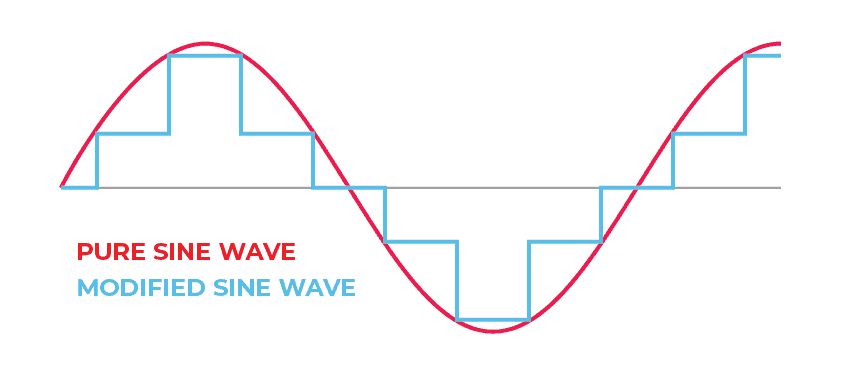
#1. Sine Wave Modified (MSW)
Multi-step wave inverters are a more appropriate name for modified sine wave inverters.
They have a straightforward construction that results in a “choppy” sine wave approximation.
The appearance of the wave doesn’t really matter for many gadgets, such as lightbulbs or power tools.
However, a clean wave is necessary to control temperature effectively and increase the longevity of sophisticated equipment with microprocessors, such as laptops and induction burners.
- When used with certain devices, MSW inverters make a “buzzing” sound and are less effective than PSW inverters.
#2. Totally Sine Wave (PSW)
Pure sine wave inverters are more expensive and need more upfront complexity.
They are more effective and allow you to plug in any AC gadget; there are no restrictions on this.
If you have the resources, we advise choosing this option.
- The ideal inverter for an RV is a pure sine wave inverter.
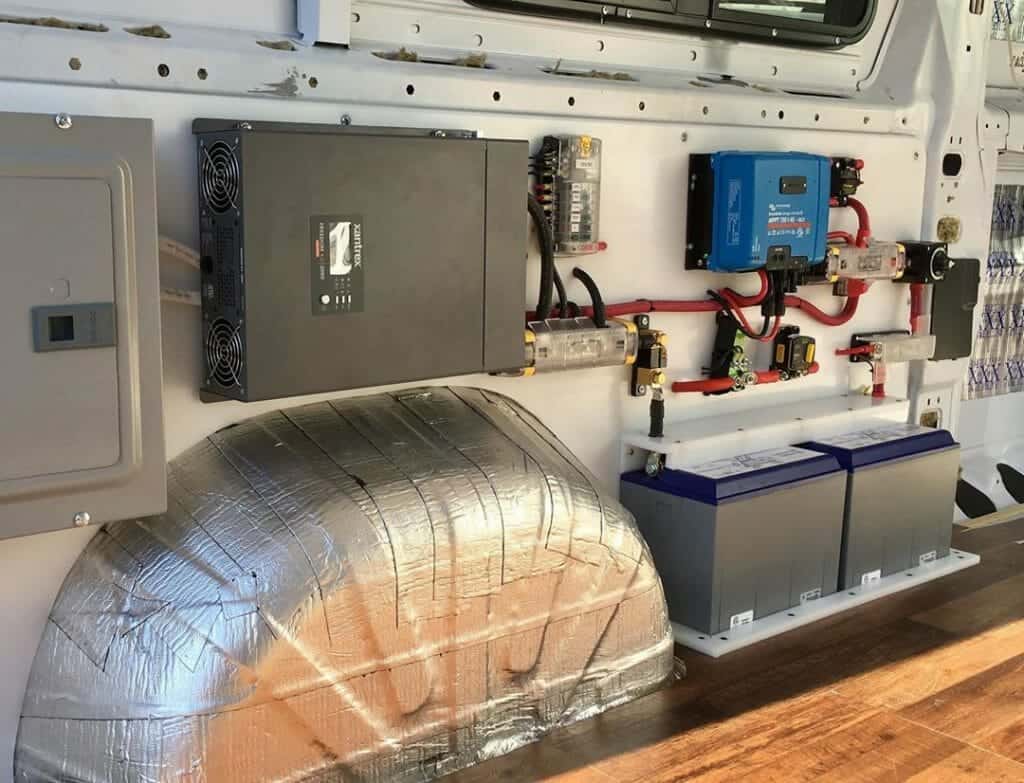
How Big to Order
The number of watts an inverter can produce determines its size.
Most are offered in peak (or surge) watts in addition to continuous watts.
- The term “Continuous Watts” describes how many watts the inverter can produce under typical operation. You should base your measurements on the inverter size that is stated.
- The inverter’s greatest output for a brief period of time is measured in Peak (or surge) Watts. The reasoning for this is because a lot of devices have a load at “start” that is much larger than their burden during “run.”
For instance, a refrigerator compressor may start off drawing 100W, but after a few seconds, it drops to a consistent 50W.
#1. Identify The Maximum Watts Per Usage.
The greatest amount of watts you will ever need at once must be calculated in order to size your inverter.
Add up all the electrical gadgets that will be plugged in simultaneously to complete this.
Choose the bigger of the two devices if you sometimes have items that you will never use together (such as an electric blanket and an AC unit).
Select an inverter with a rating that is comfortably larger than that load (120 percent or so).
To assist you in doing this, we created a solar calculator.
#2. Regular Sizes
The most popular inverter sizes bought for an RV are 2000W and 3000W.
However, you should also confirm that your battery bank is able to run your inverter/charger.
More on this is covered in our page on batteries’ charging section.
Be careful that a 30A shore power RV is only capable of 3600 watts.
Only 12,000 watts may be used by an RV with 50A shore electricity.
#3. Recommendations from Us
If you’re unfamiliar with RV power, we advise you to learn more.
Sizing an inverter may be highly specialized.
Here are some suggestions, however, if you’re simply searching for a broad guideline:
- <2000W inverter chargers work well for RV campers and weekend warriors who only use one home appliance at a time.
- 3000W inverter chargers are big enough for the majority of permanent RV campers. These are large enough to accommodate the simultaneous operation of a hairdryer and a microwave, for example.
- >3000W inverter chargers are for full-time, power-mad individuals. These are the campers that operate huge class A motorhomes, power many sizable devices simultaneously, and use energy in the same way as you would in a home.
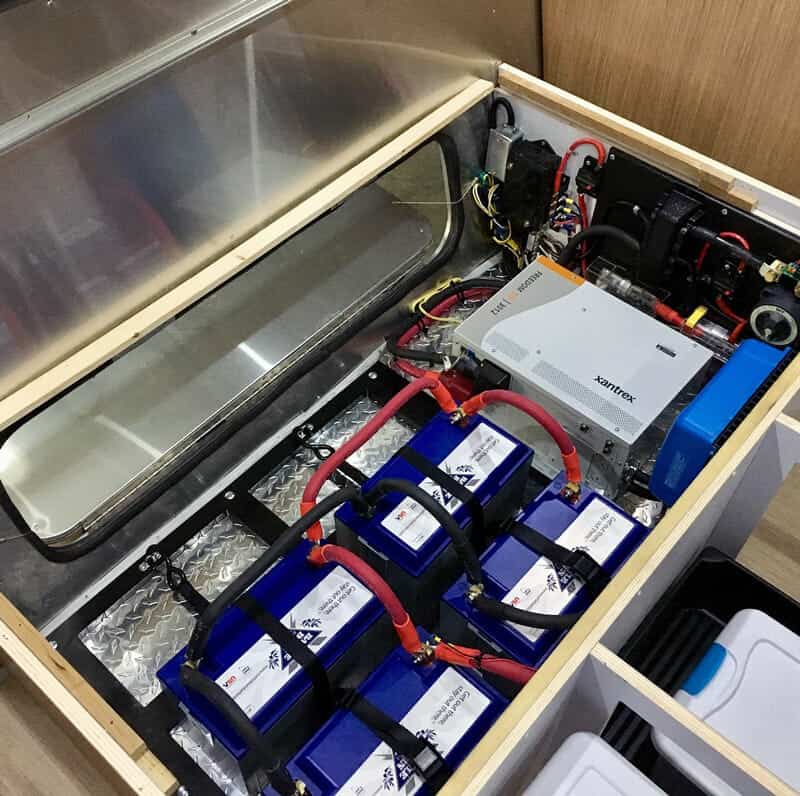
Considerations For Protections And Features
Numerous safeguards will be included in the greatest inverter brands.
These safeguards will protect the inverter itself, the RV’s electrical system, and your devices.
Some of the typical safeguards to watch out for are listed below.
- Overload
- Over-temperature
- Extreme volts
- Low volt
- Circuit short
- Fused from inside
- Alarms for low and high voltage
- Coolant fan
- Isolated ground neutrals
An Automatic Transfer Switch
An automatic transfer switch is a feature of the greatest inverter chargers.
These automatically detect generator power and block the AC Distribution Panel from receiving power from two sources at once.
In addition, if the batteries become too low, the inverter will trigger the generator to operate until the batteries are fully charged.
By doing this, the battery bank will remain full and the energy will continue to flow.
Best Inverter Charger Brands
For RV campers, there are several different manufacturers that produce inverter/chargers.
This covers a lot of Chinese knockoff goods that are available for far less money than some of the more recognizable brands.
We strongly advise buying from a reputable business because you will receive better customer service and a warranty, both of which can be extremely helpful on your road trip.
AIMS Power, Go Power!, Xantrex, Samlex, Victron, and Magnasine are a few of the most well-known and well-liked RV inverter/charger manufacturers.
How to Switch Out a Converter Charger for an Inverter Charger
A 3-stage converter or an inverter charger may be used in lieu of converters.
How to switch out your current converter for an inverter/charger is shown in this Go Power! video.
Converters are significantly outclassed by inverter/chargers.
This is a necessary item if you often go boondocking or camping off the grid.
We advise choosing the right size for your inverter and going with a reputed RV brand that will provide you with a reliable warranty and an energy-efficient equipment.

